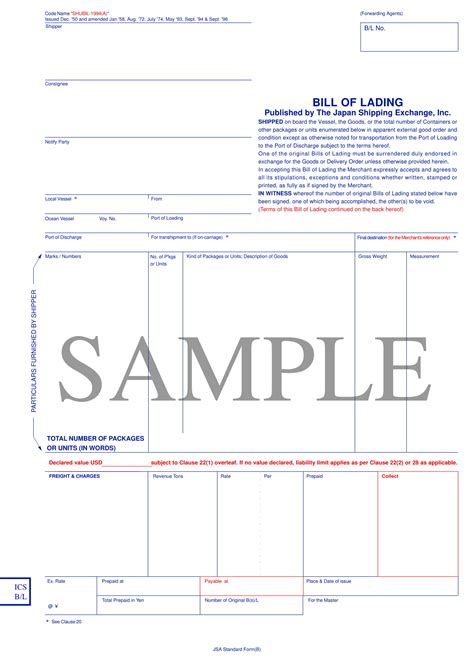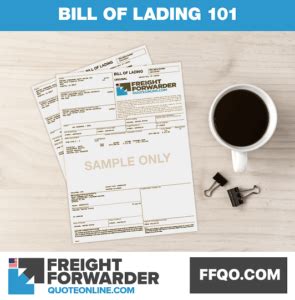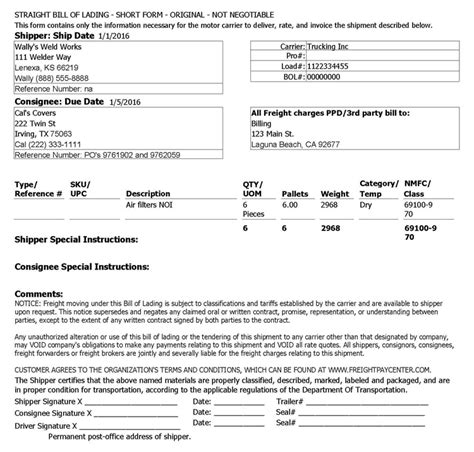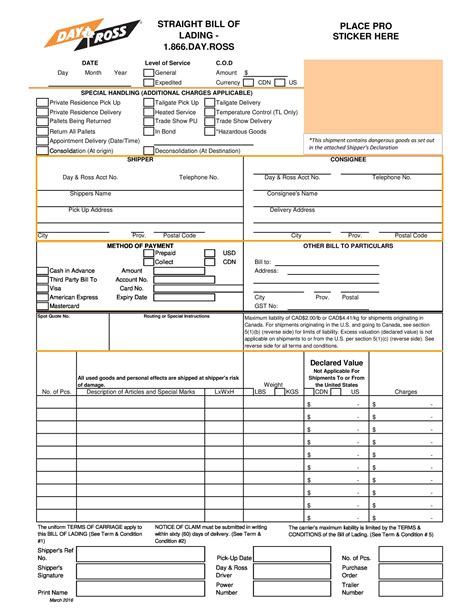Examples Of Bill Of Lading

The Bill of Lading is a crucial document in the world of shipping and logistics, serving as a vital contract between the shipper and the carrier. It provides a detailed record of the shipment, ensuring that goods are transported safely and efficiently from one location to another. In this article, we will explore various examples of Bills of Lading, shedding light on their purpose, structure, and real-world applications.
Understanding the Bill of Lading

A Bill of Lading is more than just a piece of paper; it is a legally binding document that plays a pivotal role in the international trade and transportation industry. This document acts as a receipt, a contract, and a document of title, offering comprehensive information about the goods being shipped. It outlines the shipper’s and consignee’s details, the type and quantity of goods, and the agreed-upon terms of carriage.
The importance of a Bill of Lading cannot be overstated, as it serves multiple purposes. It not only provides a record of the shipment but also acts as proof of ownership and is essential for customs clearance and insurance purposes. Furthermore, it ensures that the carrier adheres to the agreed-upon terms, safeguarding the interests of both the shipper and the consignee.
Types of Bills of Lading

Bills of Lading come in various forms, each tailored to specific shipping scenarios. Let’s explore some common types and their unique features:
Straight Bill of Lading
A Straight Bill of Lading is a non-negotiable document, often used when the shipper and consignee are known to each other. It is typically issued to a specific consignee, and the goods can only be released to that consignee or their authorized representative. This type of Bill of Lading is commonly used in domestic or regional shipments where the parties involved have established trust and relationships.
Order Bill of Lading
Unlike the Straight Bill, an Order Bill of Lading is a negotiable document, making it transferable. It is often endorsed to a third party, such as a bank or a trading company, and can be used as a means of payment or financing. This type of Bill of Lading is particularly useful in international trade, where goods may change hands multiple times before reaching the final consignee.
Sea Waybill
A Sea Waybill is an alternative to a traditional Bill of Lading, primarily used for shorter sea voyages or when the shipper and carrier have an established relationship. It simplifies the shipping process by eliminating the need for a full Bill of Lading. Sea Waybills are often used for cost-effective, time-sensitive shipments, as they can be issued and processed more quickly than Bills of Lading.
Combined Transport Bill of Lading
As the name suggests, a Combined Transport Bill of Lading is used when multiple modes of transport are involved in the shipment. It covers the entire journey, from the origin to the destination, regardless of the transportation methods used. This type of Bill of Lading is particularly beneficial for complex supply chains, ensuring a seamless transition between different modes of transport.
Multi-Modal Transport Bill of Lading
Similar to the Combined Transport Bill, a Multi-Modal Transport Bill of Lading is designed for shipments involving multiple modes of transport. However, it differs in that it is issued by a single carrier who assumes responsibility for the entire journey. This type of Bill of Lading offers simplicity and efficiency, as the carrier manages all aspects of the transportation process.
Clean Bill of Lading
A Clean Bill of Lading is issued when the goods are received in good condition and are ready for shipment. It signifies that the carrier has inspected the goods and found no visible damage or discrepancies. This type of Bill of Lading is crucial for ensuring that the goods are in acceptable condition and that the carrier is not held liable for any pre-existing issues.
Claused Bill of Lading
In contrast to a Clean Bill, a Claused Bill of Lading indicates that the goods have been received with visible damage or discrepancies. It documents the condition of the goods and may include specific clauses or remarks regarding the nature of the damage. This type of Bill of Lading is important for both the shipper and the carrier, as it clarifies any potential issues that may arise during the transportation process.
Real-World Examples and Case Studies
To better understand the practical application of Bills of Lading, let’s delve into some real-world examples and case studies:
International Trade: Exporting Machinery
Imagine a manufacturing company based in Germany that specializes in producing heavy machinery. The company receives an order from a client in the United States, requiring the shipment of several large machines. In this scenario, an Order Bill of Lading would be ideal, as it allows the manufacturer to secure payment through a letter of credit or a bank draft. The Order Bill ensures that the goods are delivered to the correct consignee and provides a means of financing the transaction.
Regional Transportation: Food Distribution
Consider a local food distributor in a major city who supplies fresh produce to various restaurants and supermarkets. The distributor regularly transports goods within the city and its surrounding areas. In this case, a Straight Bill of Lading would be suitable, as the shipper and consignees are known to each other, and the shipments are relatively short-distance and frequent.
Complex Supply Chain: Electronic Component Manufacturing
In the realm of electronic component manufacturing, a company may have a complex supply chain involving multiple suppliers and transportation methods. For instance, a smartphone manufacturer may source components from different countries, requiring air, sea, and road transportation. In such a scenario, a Combined Transport Bill of Lading would streamline the process, covering the entire journey and ensuring a smooth transition between different modes of transport.
Shipping Artifacts: Museum Exhibitions
Museums often organize international exhibitions, requiring the transportation of valuable artifacts and artwork. In this context, a Clean Bill of Lading is crucial. It ensures that the carrier has inspected the artifacts and that they are in suitable condition for transportation. The Clean Bill provides peace of mind to the museum, knowing that the carrier is not liable for any pre-existing damage.
Perishable Goods: Fruit Exports
When it comes to exporting perishable goods like fruits, time is of the essence. A Sea Waybill can be an efficient choice, as it allows for quick issuance and processing, ensuring that the goods reach their destination in a timely manner. This type of Bill of Lading is particularly useful for shipments where time sensitivity is a critical factor.
Performance Analysis and Benefits
Bills of Lading offer a range of benefits to shippers, carriers, and consignees alike. Let’s explore some of the key advantages:
Legal Protection
As a legally binding document, a Bill of Lading provides protection to all parties involved. It outlines the terms of carriage, ensuring that the carrier adheres to the agreed-upon conditions. In the event of any disputes or claims, the Bill of Lading serves as a crucial piece of evidence, helping to resolve issues fairly and efficiently.
Documentation and Record-Keeping
Bills of Lading serve as comprehensive records of shipments. They document the details of the goods, the shipper, and the consignee, providing a historical reference for future reference. This documentation is invaluable for auditing purposes, customs clearance, and tracking the movement of goods throughout the supply chain.
Negotiability and Financing
Negotiable Bills of Lading, such as the Order Bill, offer unique advantages in the world of international trade. They can be used as a means of financing, allowing businesses to secure payment before releasing the goods. This negotiability provides flexibility and financial security, especially in transactions where trust and relationships are not yet established.
Streamlined Transportation
Combined Transport and Multi-Modal Bills of Lading simplify the transportation process for complex supply chains. By covering the entire journey, these Bills of Lading eliminate the need for multiple documents and reduce administrative burdens. This streamlining ensures that goods move efficiently and seamlessly between different modes of transport.
Customs Clearance and Insurance
Bills of Lading are essential for customs clearance, as they provide the necessary details for authorities to process the shipment. Additionally, they are crucial for insurance purposes, as they document the condition of the goods and any potential liabilities. Without a Bill of Lading, the process of customs clearance and insurance claims would be significantly more challenging.
Future Implications and Innovations

As the shipping and logistics industry continues to evolve, so do the practices and technologies surrounding Bills of Lading. Here are some future implications and potential innovations:
Digitalization and Blockchain
The digitalization of Bills of Lading is gaining traction, with the aim of reducing paperwork and streamlining processes. Blockchain technology, in particular, has the potential to revolutionize the industry by providing a secure and transparent digital ledger for Bills of Lading. This would enhance efficiency, reduce fraud, and improve the overall security of shipping transactions.
Smart Contracts and Automation
The integration of smart contracts and automation into Bills of Lading could further streamline the shipping process. Smart contracts, powered by blockchain, can automate various aspects of the transportation process, including payment, tracking, and dispute resolution. This innovation would enhance efficiency and reduce the need for manual intervention.
Sustainability and Environmental Impact
With growing concerns about sustainability and environmental impact, the shipping industry is under pressure to reduce its carbon footprint. Bills of Lading could play a role in this transformation by incorporating sustainable practices and tracking environmental performance. For instance, Bills of Lading could include data on carbon emissions, encouraging carriers to adopt more eco-friendly transportation methods.
Real-Time Tracking and Visibility
The future of Bills of Lading may involve real-time tracking and increased visibility throughout the supply chain. By leveraging advanced tracking technologies, shippers, carriers, and consignees could gain real-time insights into the location and condition of goods. This level of transparency would enhance efficiency, reduce delays, and improve overall supply chain management.
Artificial Intelligence and Data Analytics
Artificial Intelligence (AI) and data analytics have the potential to transform the way Bills of Lading are utilized. By analyzing vast amounts of shipping data, AI algorithms can identify patterns, predict trends, and optimize shipping routes. This data-driven approach would enhance decision-making, improve efficiency, and reduce costs across the shipping industry.
Frequently Asked Questions
What happens if a Bill of Lading is lost or damaged during transit?
+If a Bill of Lading is lost or damaged, it can be replaced with a duplicate copy. However, this process may require additional documentation and verification from the shipper and carrier. It is crucial to have backup copies or digital records to ensure smooth operations in such cases.
Can a Bill of Lading be used for multiple shipments or consignments?
+Yes, a Bill of Lading can be used for multiple shipments or consignments, especially in the case of a Multi-Modal or Combined Transport Bill. These Bills cover the entire journey, regardless of the number of shipments involved. However, it is essential to ensure that the Bill accurately reflects the details of each consignment.
How does a Claused Bill of Lading affect insurance claims?
+A Claused Bill of Lading, which indicates visible damage or discrepancies, can impact insurance claims. It serves as evidence of the condition of the goods at the time of receipt. If a claim is made for damage or loss, the Claused Bill can be used to support the claim and determine liability.
Are there any international standards or regulations governing Bills of Lading?
+Yes, international standards and regulations exist to govern Bills of Lading. The most widely recognized set of rules is the International Chamber of Commerce’s (ICC) Incoterms. These rules provide a standardized framework for international trade, including the use of Bills of Lading. Adhering to these rules ensures consistency and clarity in shipping transactions.
How can digitalization improve the efficiency of Bills of Lading processes?
+Digitalization of Bills of Lading can enhance efficiency by reducing paperwork, minimizing errors, and speeding up the overall shipping process. Digital Bills of Lading can be easily shared, stored, and accessed, improving communication and collaboration between shippers, carriers, and consignees. Additionally, digitalization can streamline customs clearance and reduce administrative burdens.


